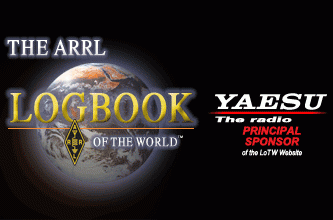Trusted QSL V2.6.4 Released
TQSL is free software used to upload and sign logs to the ARRL Logbook of the World (LoTW). TQSL works with Windows, MacOS and Linux. LoTW is free to all Amateur Radio Operators around the world, and membership in the ARRL is not required to use LoTW.
The latest version of TQSL can be downloaded from the ARRL website.
Trusted QSL V2.6.4 Release Notes
This version of Trusted QSL (TQSL) has a corrections for a defect found since TQSL 2.6 was released and some less critical updates.
Updates since TQSL 2.6: 
[2.6.1] This release includes an update to correct a defect that could cause TQSL to “hang” and never complete signing a log when previously submitted QSOs were submitted for signing.
[2.6.2] Several minor usability updates were implemented. See details below.
TQSL 2.6.4 can be installed to upgrade any older version of TQSL.
For the Mac platform, TQSL now uses a package file (.pkg) for installing TQSL. This is hopefully easier to use as it is a familiar way to install software for most Mac users.
On all three supported platforms (Windows, MacOS, and Linux), installing TQSL 2.6.4 will replace older
versions of Trusted QSL while preserving your Callsign Certificates, Station Locations, and preferences.
On Windows, simply run the TQSL 2.6.4 installer, which will automatically uninstall older versions of
TQSL (and, if installed, TQSLCert). On Mac OS X, open the package (.pkg) file to install TQSL into your
Applications folder. (Note that the “tqsl-legacy” package is for legacy Mac systems – 32 bit Intel and
PowerPC.) Direct the installer to “Replace All”, which will uninstall old files. For Linux systems, unpack
the tar file and read the INSTALL file for directions.
TQSL 2.6.4 has been “localized” to allow use in the native language of non-English speakers. This could not have been done without the help of the volunteers who have contributed translations for TQSL.
Thanks to the following for their assistance:
Catalan: Xavier, EA3W
Chinese (Simplified): SZE-To, VR2UPU
Chinese (Traditional): Caros, BH4TXN
Finnish: Juhani, OH8MXL
French: Laurent BEUGNET, F6GOX
Hindi: Manmohan, VU3YBH
German: Andreas, DF4WC
Italian: Salvatore, IV4FYV
Japanese: Akihiro, JL3OXR
Portuguese: Nuno, CT2IRY
Russian: Vic, US5WE
Spanish: Jordi, EA3GCV
Swedish: Roger, SM0LTV
Turkish: Ojuzhan, TA2NC
The following list describes the major changes in the v2.6.4 release of Trusted QSL.
TQSL changes
Defects Corrected:
[2.6.1] When signing a log with QSOs which were detected as previously uploaded, TQSL would ask the
user how to handle these. If the response was to re-upload those QSOs, TQSL would re-process the log,
then ask again how to handle the previously uploaded QSOs. The only way out of this was to cancel the signing operation. When this operation was performed by a command-line signing (such as being done
for a logging program) that asked to include all QSOs in the upload (including previously uploaded
QSOs), TQSL would enter a CPU-bound loop and never complete the signing.
This release of TQSL corrects this defect by reverting to the prior behavior.
[2.6.2] Add changes to allow building with OpenSSL version 3.
[2.6.3] Add the name of the file to the station location verification screen when signing a log.
[2.6.4] When checking callsign validity, allow both “K1MU/KH6” and “KH6/K1MU” forms of the portableMajor feature Additions:None.Minor Updates:[2.6.2] Expand the “Gridsquare” field to allow the full set of four 6-character grids.
[2.6.4] Correct the cause of a crash when TQSL detects an expiring callsign certificate and the user chooses to renew that certificate.
[2.6.4] When signing a log, TQSL checks if there are any valid callsign certificates for that call before allowing signing to proceed. This check caused station locations with “None” as their callsign to be rejected when signing a log. This is now corrected to permit the station location to be used.
[2.6.2] Add an option for new callsign certificate requests for Club calls, DXpeditions, and QSL managers so the proper account setup is used.
[2.6.2] Allow the properties of an expired Callsign Certificate to be displayed when right clicking on that Callsign Certificate.
[2.6.3] Don’t do a ULS check to validate that the callsign is a valid FCC-issued call if the callsign certificate request has an end date.
[2.6.3] Handle the case where there’s two callsign certificates installed for a given callsign and one is invalid. TQSL would, if it saw the invalid callsign certificate first, abort signing. TQSL now continues to search for a valid callsign certificate.
[2.6.4] When checking QSOs to detect those previously uploaded, TQSL detects changes in the Station
Location and warns about those changes. This has been relaxed to allow empty station location details
to be later filled in, and allows the updated QSO to be updated. (For example, if you update a Station
Location to have an ITU Zone when one was previously not provided, this QSO is allowed to be
uploaded.) Changes to any of the Station Location fields are not allowed unless the user elects to re-
upload the QSO.
[2.6.4] When checking a Callsign Certificate to determine if it is still valid, and that callsign certificate is found to have an invalid serial number, TQSL would abort signing – even if there was a second, valid, callsign certificate for that call. TQSL now treats these invalid callsign certificates as expired.
Reinstalling TQSL 2.6
Downgrading to TQSL 2.6 can be seamlessly performed by uninstalling TQSL 2.6.x and reinstalling TQSL2.6.

